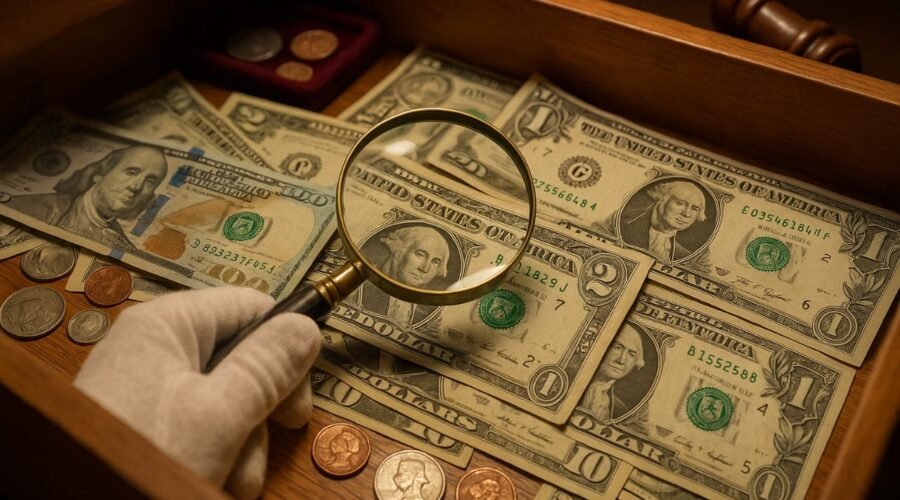Cash In Your Drawer- Rare U.S. Money Finds You Could Have Right Now
Most people toss coins and bills into a kitchen drawer or glove box.
But certain mint errors, low-mintage issues, and special serial numbers can transform small change into serious cash.
With a few quick inspections—no expensive tools—you can spot collectibles that regularly sell above face value.
Top Coin Finds To Check First
- 2000-P Sacagawea/Quarter Mule: A dramatic error pairing a Washington quarter obverse with a Sacagawea reverse. If you spot a quarter front with a golden-dollar back, you may have a jackpot.
- “Cheerios” Sacagawea Dollar (Bold Tail Feathers): Seeded in cereal boxes in 2000; look for strong, detailed feather veins on the eagle’s tail.
- 2004-D Wisconsin Quarter “Extra Leaf” (High/Low): On the ear of corn, an extra leaf appears above or below the husk.
- Lincoln Cent Wide/Close AM Varieties:
- 1998–2000 Wide AM: The A and M in AMERICA are clearly separated.
- 1992 & 1992-D Close AM: The A and M nearly touch.
- Doubled Dies On Cents:
- 1969-S DDO (obverse doubling on date/legends).
- 1983 DDR (reverse doubling on UNITED STATES OF AMERICA / ONE CENT).
- State Quarter Die Cracks/Breaks:
- 1999 Delaware “Spitting Horse” (crack from the horse’s mouth). Smaller premiums, but easy to spot in change.
Paper Money Finds That Add Up
- Star Notes: A ★ star after the serial number indicates a replacement note. Some runs are scarcer and bring premiums.
- Fancy Serial Numbers: Look for radars (e.g., 12344321), repeaters (e.g., 12121212), ladders (e.g., 01234567), solids (e.g., 77777777), or very low numbers (e.g., 00000025).
- Condition Matters: Crisp, uncirculated notes and notes in protective sleeves sell best.
Quick Reference Table: What To Look For
| Find/Type | How To Identify | Typical Value Reality* |
|---|---|---|
| 2000-P Sacagawea/Quarter Mule | Quarter front + Sacagawea back | Four to six figures in top condition |
| “Cheerios” Sacagawea (Bold Tail Feathers) | Deep, bold tail-feather veins | Thousands in certified grades |
| 2004-D Wisconsin “Extra Leaf” | Extra high/low leaf on corn | Hundreds; more if uncirculated |
| 1998–2000 Wide AM Cent | Gap between A and M on AMERICA | $10–$1,000+ by grade |
| 1992/1992-D Close AM Cent | A and M almost touching | Strong premiums; scarce |
| 1969-S DDO / 1983 DDR Cents | Strong doubling in date/legends | Hundreds to five figures by grade |
| 1999 DE “Spitting Horse” | Die crack from horse’s mouth | Modest premium; higher uncirculated |
| Star/Fancy Serial Notes | ★ star or special pattern | Small to significant premiums |
*Actual prices depend on grade, certification, rarity, and buyer demand.
How To Check Fast (At Home)
- Good Light + 5–10× Loupe: Lighting reveals doubling and die cracks quickly.
- Compare Letter Spacing: For Wide/Close AM, study the AMERICA spacing with a clear photo reference.
- Weigh & Measure (Optional): A small digital scale helps verify oddities and rule out altered pieces.
- Photograph Diagnostics: Sharp photos of the error area (tail feathers, AM spacing, extra leaf) help buyers and graders.
- Consider Grading: Third-party certification often boosts confidence—and sale prices—especially for high-value errors and varieties.
Selling Tips That Protect Your Profit
- Never Clean Coins: Cleaning can permanently reduce value.
- Check Recent Comps: Search for completed sales of the exact variety and grade, not asking prices.
- Choose The Right Venue: Major auction houses for big errors; reputable marketplaces or local dealers for common premiums.
Your junk drawer might hold more than pocket change.
Target well-documented winners—mule errors, Cheerios dollars, Wisconsin Extra Leaf quarters, Wide/Close AM cents, strong doubled dies, and star/fancy serial notes—and verify with simple at-home checks.
With careful photos, honest grading, and smart selling, you could turn overlooked coins and bills into real cash—without spending a fortune to get started.
FAQs
Are Bicentennial quarters valuable by default?
No. Most are face value. Only high-grade examples, special finishes, or true errors/varieties bring premiums.
Do star notes always beat face value?
Not always. Print-run size, condition, and the serial pattern decide whether it’s worth more.
Should I slab every coin or note?
No. Certification fees make sense for items with clear scarcity, strong condition, or well-known varieties.


Leave a Reply